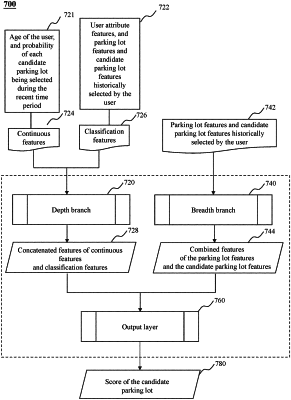| CPC G08G 1/141 (2013.01) [G08G 1/0129 (2013.01); G08G 1/146 (2013.01); G08G 1/148 (2013.01); G16Y 20/10 (2020.01); G16Y 40/10 (2020.01)] | 18 Claims |

|
1. A method for recommending a parking lot in a smart city, implemented based on an Internet of Things system for recommending the parking lot in the smart city, including:
determining an arrival duration of a user reaching at least one candidate parking lot and a prediction time period corresponding to each candidate parking lot in the at least one candidate parking lot based on a user request;
determining an occupation rate of the candidate parking lot during the prediction time period; and
determining a recommended parking lot at least based on the occupation rate of the candidate parking lot during the prediction time period and parking lot information of the candidate parking lot;
wherein the parking lot information further includes at least one of a historical occupation rate of the parking lot, a parking lot capacity, and surrounding event holding information; and
the determining the occupation rate of the candidate parking lot during the prediction time period includes:
constructing a parking lot feature vector corresponding to the candidate parking lot based on the parking lot capacity of the candidate parking lot, an internal structure of the parking lot, and the surrounding event holding information during the prediction time period;
obtaining a reference historical vector through retrieving in a vector database based on the parking lot feature vector; and
using the historical occupation rate of the parking lot corresponding to the reference historical vector as the occupation rate of the candidate parking lot during the prediction time period.
|